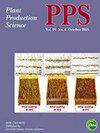Plantain hybrids for the humid forest agroecology of Central Africa – diseases and pests load, fruit yield and farmers perception
IF 1.3
3区 农林科学
Q2 AGRONOMY
引用次数: 0
Abstract
ABSTRACT Plantain is one of the major staples contributing to food security and income generation in West and Central Africa. Local cultivars in Cameroon are susceptible to pests and diseases causing severe losses in plantain production. This study aimed at evaluating the agronomic performance and producer’s perception of plantain hybrids in the humid forest of Cameroon. Field trials were established in a completely randomized block design with eight genotypes and three replicates. Data on pest and disease as well as farmer perception were collected over two growing cycles. These genotypes included seven improved and one local genotype (check). Improved genotypes were highly tolerant to the Black Sigatoka disease compared to local plantain. While root necrosis index was above 50% in local varieties, indices below 25% were recorded in hybrids. Weevil severity in local was higher (55.0 ± 5.2%) compared to 21.0 ± 4.6% to 28.5 ± 3.2% in improved plantains. Average bunch weight was higher for FHIA 21 with 17.9 ± 0.7 kg in the first and 19.7 ± 0.3 kg for the second cycle, while those of the local Ebang were 9.6 ± 0.5 kg and 12.8 ± 0.9 kg, respectively. FHIA 21 and CRBP 568 were the preferred varieties by farmers (68.8% and 56.3% acceptance) from an agronomic perspective. The consumers’ preferences for all the genotypes varied with types of cooking. The implications of these findings for adoption by farmers and consumers as well as for the promotion of the plantain sector in central Africa are discussed. GRAPHICAL ABSTRACT中非湿润森林农业生态的大蕉杂交种——病虫害负荷、果实产量和农民感知
摘要车前草是促进西非和中非粮食安全和创收的主要作物之一。喀麦隆当地品种易受病虫害影响,导致芭蕉生产严重损失。本研究旨在评估喀麦隆潮湿森林中大蕉杂交种的农艺性能和生产者的感知。现场试验是在一个完全随机的区块设计中建立的,有八种基因型和三个重复。关于病虫害以及农民感知的数据是在两个生长周期内收集的。这些基因型包括7个改良基因型和1个局部基因型(对照)。与当地的芭蕉相比,改良的基因型对黑Sigatoka病具有高度耐受性。虽然本地品种的根坏死指数在50%以上,但杂交种的根坏死指标低于25%。与改良芭蕉的21.0±4.6%和28.5±3.2%相比,本地的象甲严重程度更高(55.0±5.2%)。FHIA 21的平均束重较高,第一周期为17.9±0.7 kg,第二周期为19.7±0.3 kg,而局部Ebang的平均束重量分别为9.6±0.5 kg和12.8±0.9 kg。从农艺学角度来看,FHIA 21和CRBP 568是农民的首选品种(接受率分别为68.8%和56.3%)。消费者对所有基因型的偏好因烹饪类型而异。讨论了这些发现对农民和消费者采用以及促进中部非洲芭蕉行业的影响。图形摘要
本文章由计算机程序翻译,如有差异,请以英文原文为准。
求助全文
约1分钟内获得全文
求助全文
来源期刊

Plant Production Science
农林科学-农艺学
CiteScore
5.10
自引率
4.00%
发文量
27
审稿时长
>36 weeks
期刊介绍:
Plant Production Science publishes original research reports on field crops and resource plants, their production and related subjects, covering a wide range of sciences; physiology, biotechnology, morphology, ecology, cropping system, production technology and post harvest management. Studies on plant production with special attention to resource management and the environment are also welcome. Field surveys on cropping or farming system are also accepted. Articles with a background in other research areas such as soil science, meteorology, biometry, product process and plant protection will be accepted as long as they are significantly related to plant production.
 求助内容:
求助内容: 应助结果提醒方式:
应助结果提醒方式:


